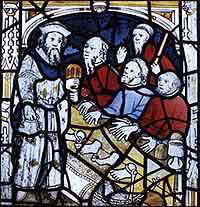|
The Melbourne Manuscript Resource Unit
The Melbourne Manuscript Resource Unit is associated with the University of Melbourne. It is located in a splendid new library and information technology centre (the Academic Centre) adjoining the University, by courtesy of Newman and St Mary’s Colleges, and in addition to being available to honours and postgraduate students in the various disciplines which involve the history of the book before printing, the Unit will provide opportunities for interdisciplinary research and communication with specialist groups such as curators, dealers, collectors, and the interested public.
The basic resource is a specialist library on manuscript studies,which has been assembled over almost half a century of teaching and research in this area. The Resource Unit will also co-ordinate and circulate information about the resources for manuscript studies available in Australasia. These include: the manuscript collections in the public libraries and art museums of Australia and New Zealand; the comprehensive collection of high quality manuscript facsimiles in the Rare Books and Special Collections of the Baillieu Library, The University of Melbourne; the in-depth collections on manuscripts in the reference sections of the Melbourne (Baillieu), Latrobe and Australian National University libraries, and in public libraries such as the State Library of Victoria and the National Library of Australia; and the slides and microfilm collections of the art history departments of Melbourne and Latrobe Universities. The Resource Unit will also develop a guide to information on the Web relevant to: the digitization of manuscripts and their images; the cataloguing of manuscript collections world-wide; and specialist reference material.
In particular the Resource Unit will support the collaborative activities of the newly formed Research Cluster for Manuscript Studies.
The Research Cluster for Manuscript Studies
The study of illuminated manuscripts has been a specialization of Melbourne University's Department of Fine Arts (Art History) for many years. Research achievements in this area include a series of team projects funded by the Australian Research Council (ARC) and a steady stream of distinguished doctoral, masters and honours theses. These activities have resulted in the publication of books, articles and catalogue entries for international exhibitions. Many of these publications are now routinely cited in the scholarly literature.
The formation of the Research Cluster for Manuscript Studies as part of NEER, the ARC Network for Early European Research, initiates a new phase in this specialization. Foundation members comprise a group of experienced, mid-career, early career and postgraduate researchers in Manuscript Studies (See Profiles). The Cluster is affiliated with the University of Melbourne through its co-ordinator, Emeritus Professor Margaret Manion. Its members belong to academic institutions throughout Australia, New Zealand and the United Kingdom. While there is an emphasis on manuscript illumination, a strong interdisciplinary element is also present, and research interests of Cluster members include
English, History, Art History, Palaeography, Codicology, Liturgical Studies and Textual Criticism.
Aims and Objectives of the Research Cluster
The Cluster aims to provide research leadership in the next phase of the development of manuscript studies in Australia and New Zealand. Its aims and objectives include:
1) to foster collaboration between younger scholars based in Australia and New Zealand and more experienced researchers both in the carrying out of joint projects and the development of individual initiatives.
2) to ensure that the manuscript holdings of Australia and New Zealand continue to be the subject of high quality research and publication, and that the digital imaging of these works is accompanied with information based on the latest research. To this end, the Cluster will seek to advance the positive relationships which already exist between specialist academics and the curatorial staff responsible for this material;
3) to develop and facilitate quality publications in manuscript studies, that are directed both to specialists and the interested public, and to help secure the long-term funding needed to carry out and to publish high quality research in this area;
4) to collaborate with the Centre for Medieval Studies in Auckland which is focusing on that country's manuscript holdings and has welcomed collaboration with scholars based in Australia;
5) to foster international networks in manuscript studies, which will be of mutual benefit in the exchange of information and the gaining of access to research material;
6) to found the Australia and New Zealand Association for Manuscript Studies and the Early Printed Book. It is planned to launch this Association at the February Conference, 2007, and in due course to seek affiliation with similar associations internationally.
|
